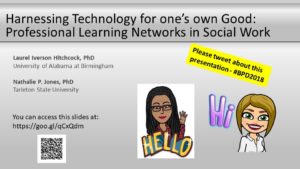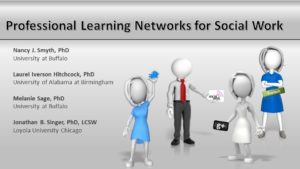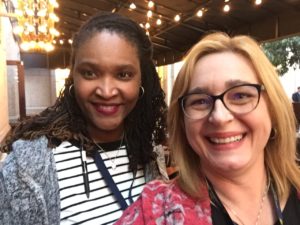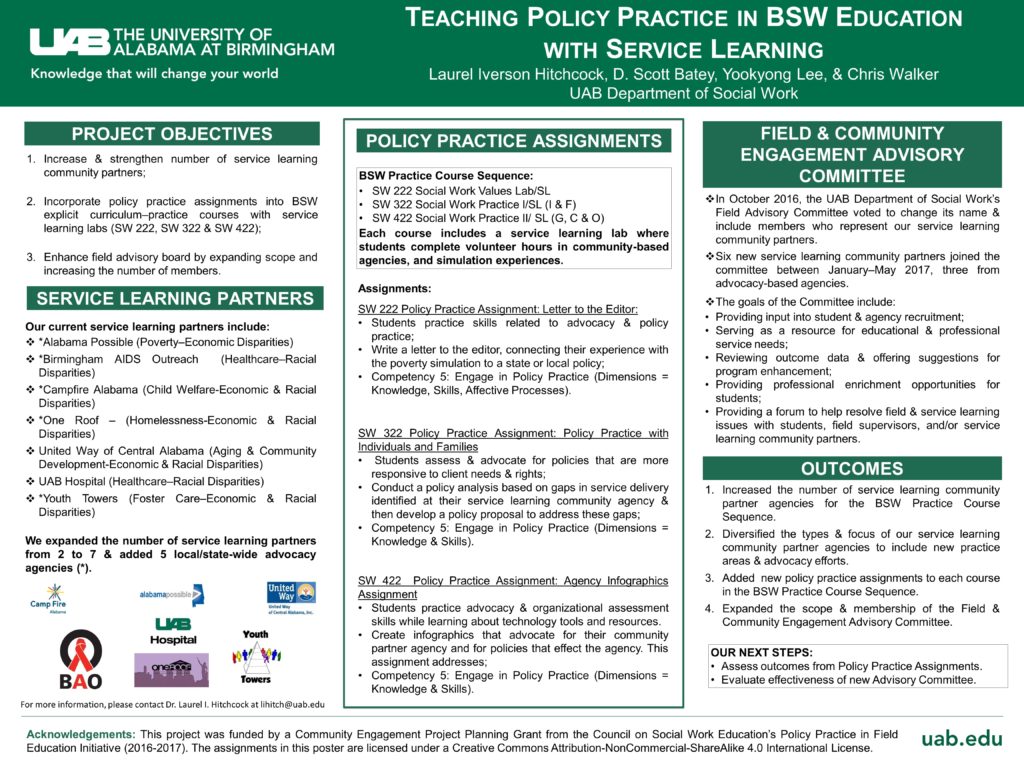#SW2018 Visualizing Data: Infographic Assignments across the Social Work Curriculum
This year at the 4th Annual Social Work Distance Education conference, Nathalie Jones of Tarleton State University, Melanie Sage of the University at Buffalo and I presented on the use of infographics in the social work curriculum. This blog post does a few things: 1) it offers an example of infographics as a tool for improving digital literacy; 2) it offers a sample of what a hands-on conference workshop proposal looks like, and; 3) it helps us share our research.
The three of us (Laurel, Nathalie, Melanie) have been working together on polishing our infographic assignments for a few years. In a previous blog post, we offer assignment details and even rubrics you can use to build your assignments if you are a social work educator. We share these in the spirit of service to our profession and to support your work.
We’ve been using infographics as an assignment in our classrooms for several years and have even collected some data across our universities to ask students about the pros and cons. Guess what? The students overwhelmingly love infographic assignments. They appreciate working their creative muscles, like the opportunity to learn a new and transferable skill, and say they’ll use infographics again. Also, the technology can be a little bit frustrating, and some students are uncomfortable with the lack of structure. (We argue that it’s good for students to sometimes get uncomfortable with lack of structure- this experience of managing some ambiguity is an important practice skill, as we know well!)
Here are the slides from the presentation:
#BPD2018 Harnessing Technology for one’s own Good: Professional Learning Networks in Social Work
 Today, Dr. Nathalie Jones and I will be presenting about Professional Learning Networks (PLNs) at the Association of Baccalaureate Social Work Program Directors in Atlanta, GA. This year’s theme is the Grand Challenges of Political Change, and we have been talking with our colleagues about how do we, as social workers, affect change in today’s political and social environments – change to improve the lives of vulnerable populations we serve; change to improve learning outcomes for our students; and change for ourselves as social work educators. Nathalie and I share a common desire to help other social work educators develop their own tool kits for teaching, scholarship, and service in their lives as academics, mentors, and partners with constituents and communities. One tool that we know works is having a Professional Learning Network, and we know this because it has worked for us – we met via Twitter using our PLNs. We have been working with our good colleagues – Drs. Melanie Sage and Nancy J. Smyth (both at the University at Buffalo) – to share what we know about PLNs to help raise awareness about this tool in social work education and practice.
Today, Dr. Nathalie Jones and I will be presenting about Professional Learning Networks (PLNs) at the Association of Baccalaureate Social Work Program Directors in Atlanta, GA. This year’s theme is the Grand Challenges of Political Change, and we have been talking with our colleagues about how do we, as social workers, affect change in today’s political and social environments – change to improve the lives of vulnerable populations we serve; change to improve learning outcomes for our students; and change for ourselves as social work educators. Nathalie and I share a common desire to help other social work educators develop their own tool kits for teaching, scholarship, and service in their lives as academics, mentors, and partners with constituents and communities. One tool that we know works is having a Professional Learning Network, and we know this because it has worked for us – we met via Twitter using our PLNs. We have been working with our good colleagues – Drs. Melanie Sage and Nancy J. Smyth (both at the University at Buffalo) – to share what we know about PLNs to help raise awareness about this tool in social work education and practice.
We hope you will join us at 1:45 PM in Georgia 2 in the Atlanta Sheraton. We will describe what what a PLN is and why to use one; demonstrate how to establish your own PLN and how to incorporate; and share how theory helps to inform the process of adopting technology tools for social work practice and education.
Here is a link to the slides from our workshop: https://goo.gl/qCxQdm.
You can also access a copy of the Professional Learning Network (PLN) Worksheet.
Review of Teaching & Learning in Social Work for 2017
 One of my favorite things to do at the end of the year is to read all of the “year-in-review” lists. Books, records, movies, top ten social work journal articles – it doesn’t matter what the list is about, I’ll read it. I am always curious how and why people choose to rank their favorite things from the year. This must be because I find it hard to choose a favorite book or movie when there are so many good options, and how can I exclude anything as a social worker, the profession that loves diversity and strives for inclusion. So for 2017, I offer a list for the Teaching & Learning in Social Work Blog. Not the top-ten blog posts, but the entire year. Here are the numbers:
One of my favorite things to do at the end of the year is to read all of the “year-in-review” lists. Books, records, movies, top ten social work journal articles – it doesn’t matter what the list is about, I’ll read it. I am always curious how and why people choose to rank their favorite things from the year. This must be because I find it hard to choose a favorite book or movie when there are so many good options, and how can I exclude anything as a social worker, the profession that loves diversity and strives for inclusion. So for 2017, I offer a list for the Teaching & Learning in Social Work Blog. Not the top-ten blog posts, but the entire year. Here are the numbers:
Number of Blog Posts in 2017 – My goals was to write or publish at least two posts a month, which happened more months than not:
Total Blog Posts = 25
Highest number of Blog Posts published in one month = 6 (October)
Lowest number of Blog Posts published in one month = 0 (August)
Guest Educator Posts in 2017 – Another goal I have for this blog is to provide a space for others to share their work, particularly work that does not fit into the traditional academic publication venues. For 2017, I am thrilled that eight social work educators wrote seven different blog posts about their scholarship of teaching and learning for the blog. I want to thank all of these authors for sharing their work and for all they do to educate future social workers!
Scholarship Dissemination Posts – My final goal for the year was to write more about my own scholarship by sharing content from conference presentations and any published articles. I published seven posts about national conference presentations with colleagues, and wrote about one article I had published in 2017. Clearly, I am doing more conferencing than publishing.
Below is a list of this year’s post grouped around the topics of assignments, projects, guest educator posts, and conference presentations.
#APM17 – Harnessing Technology for one’s own Good: Professional Learning Networks in Social Work
 On 10/22/17, the last day of CSWE’s 2017 Annual Program Meeting, at 10:00 AM in the Dallas Ballroom A-2, Nancy J. Smyth, Melanie Sage, Jonathan Singer, and I are presenting about how social work educators can use technology for career-long learning. Nancy, Melanie and I introduced the idea of professional learning networks (PLN) to a packed room at Social Work Distance Education Conference in April, and wanted to bring the practice to the #APM17 crowd. A PLN incorporates technology-based tools and processes in a way that allows individuals to stay up-to-date and share information about current news, practice knowledge and current research findings. We will be talking about the mechanics, advantages and disadvantages of establishing a PLN. One resources we will be sharing is our Professional Learning Network (PLN) Worksheet, which takes a social worker through the steps of creating their own PLN. You can get your own copy here: https://drive.google.com/file/d/0ByR_E-iQH7PdT2t1WV9YYnlZV00/view?usp=sharing
On 10/22/17, the last day of CSWE’s 2017 Annual Program Meeting, at 10:00 AM in the Dallas Ballroom A-2, Nancy J. Smyth, Melanie Sage, Jonathan Singer, and I are presenting about how social work educators can use technology for career-long learning. Nancy, Melanie and I introduced the idea of professional learning networks (PLN) to a packed room at Social Work Distance Education Conference in April, and wanted to bring the practice to the #APM17 crowd. A PLN incorporates technology-based tools and processes in a way that allows individuals to stay up-to-date and share information about current news, practice knowledge and current research findings. We will be talking about the mechanics, advantages and disadvantages of establishing a PLN. One resources we will be sharing is our Professional Learning Network (PLN) Worksheet, which takes a social worker through the steps of creating their own PLN. You can get your own copy here: https://drive.google.com/file/d/0ByR_E-iQH7PdT2t1WV9YYnlZV00/view?usp=sharing
You can access a copy of the presentation slides here: https://www.slideshare.net/laurelhitchcock/professional-learning-networks-for-social-work-81048022
#APM17 Day 1 – Infusing Policy Practice into BSW Service Learning Courses
As part of the Field Education Institute, I am presenting a poster with my colleagues Scott Batey, Yookyong Lee, and Chris Walker (University of Alabama at Birmingham) about the work we did for our Policy Practice in Field Education Initiative Grant from the Council on Social Work Education.
Our project involved creating more policy-based learning opportunities into our undergraduate service learning courses, creating a series of policy-focused activities that are grounded in community-based settings. Our curriculum includes three practice courses with a one-hour service-learning lab. Students take the courses sequentially and complete 32 hours in service learning at a community-based agency or simulation for each lab. By integrating policy-focused learning activities into these service-learning labs, we hope to bridge the gap between our policy courses and field education while simultaneously providing all of our students the opportunity to see how policy affects communities and agencies in our state, especially related to issues of economic and racial disparities. Our specific objectives for this planning grant included: 1) Incorporate at least one policy-based assignment or learning opportunity into each of the service learning labs in our practice sequence; 2) increase and strengthen the number of service learning community partners with local and state-wide advocacy agencies focused on addressing issues of economic and racial disparities; and 3) Enhance our field advisory board by increasing membership to include community partners from our service learning projects, especially partners from policy-based agencies.
Here is a copy of our poster:
Harnessing Technology for Social Work Scholarship: #CSWResearch Day at Ohio State University
The blog post was written by myself and Melanie Sage of the University at Buffalo, and we describe our visit with the College of Social Work at the Ohio State University in August 2017, where we talked about how social work faculty can harness technology for their social work scholarship. We also interviewed two of our OSU colleagues, Drs. Bridget Freisthler and Holly Dabelko-Schoeny, about our presentation and how it supports their use of technology for scholarship. This is cross-posted at the Human Services Information Technology Association’s (HusITa) Blog: http://www.husita.org/harnessing-social-media-for-social-work-research-and-scholarship/.
Dissemination to the right stakeholders is a crucial part of social work research. However, as social work academics, we are often trained to think that publication in peer-reviewed journals is the pinnacle of sharing our research with our peers and the academy. But for our work to have substantial impact, we want it to reach service providers, communities, and consumers, too. Access to peer-reviewed journals can be challenging due to cost,availability, and complexity. Increasingly, academics and research scientists are turning to social media platforms as a way to disseminate and engage with others about their work.
One of the early studies looking at the value of social media in research dissemination was an article by Darling, Shiffman, Côté, and Drew (2013) titled The role of twitter in the life cycle of a scientific publication. Based on a survey of 116 marine biologists, they found that scientists who used Twitter for professional reasons could rapidly develop new research ideas and easily share works-in-progress for pre-reviews. Additionally, these researchers found they could communicate their findings not only with other academics, but also with broader audiences such as decision makers, journalists and the public in a way that could amplify the scientific and social impact of publications, and that sharing in this way increased their citations too. Here is an infographic of the article’s major findings.
So how does this translate to social work research? Melanie Sage and I present to multiple audiences, from peers to conference attendees, about the role of social media in social work scholarship. For years, we have been using social media and technology tools to connect with colleagues, share research, and collaborate. Based on our expertise in this area, we were invited to lead a discussion about the role of technology in social work scholarship at the Social Work’s Grand Challenge Initiative Conference (#GC4SW) held at the University of Southern California (April 25-28, 2017). In this discussion, we shared the ways in which social media can be a tool to help social work academics and practitioners to discover and share knowledge, as well as build relationships for collaborative work. Social media platforms are well-placed to allow social workers across the professional continuum to engage with each other, creating communities of learning and practice that bridge the gap between practice and research in social work. We suggested four practices with social media for advancing the Grand Challenges for Social Work; you can read about them here.





